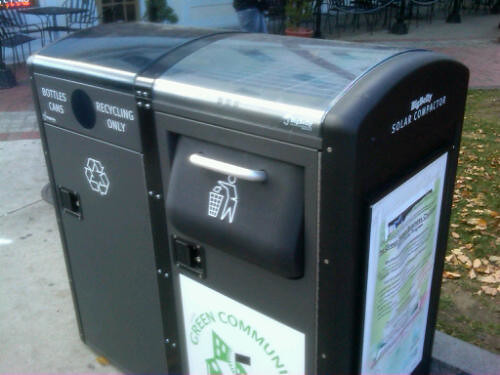Photo: a solar-powered Big Belly trash compactor seen in Salem, Massachusetts, next to a recycling bin. Solar photovoltaic panels power this receptacle.
Today I'd like to comment on the story of the Brantley Dam on the Dan River in Danville, Virginia (about 4 hours west of Norfolk). This older dam once provided water to the now-closed Brantley Steam Plant. Over the years of changing ownership and possibly insufficient maintenance, the dam has recently become unpopular. Dam safety is a major issue, with 4 deaths since 1965 attributed to the dam.
The City of Danville Public Works department has issued a report recommending that the Brantley Dam be removed. The City is now considering removing the dam, and whether sediments trapped in the impoundment behind the dam may be toxic or polluted. The report suggests a variety of costs for dam removal, ranging from $90,000 for a "simple removal", $110,000 for a “staged removal" - or about $307,000 to remove the dam along with the entirety of the trapped sediments. Based on the relatively low amount of sediments, the report suggests simple removal is appropriate.
I'm curious to see what will happen with dam removal on the Dan River. A number of other dams exist across the watershed, some of which are privately owned, and at least one of which (at a water treatment plant) is a partially breached low-head dam - picture a 30' breach in the middle of a short, curving structure.
In this case, the dam played a role in energy generation, though not through hydroelectric capacity; rather, like the Briggsville Dam in Clarksburg, Massachusetts, it was built to provide a steady supply of water for industrial processes. In this case, the Brantley Dam supplied water to the steam plant electric generation station. As the economy of industrial production has shifted over the past century, the underlying factory or power plant may change its operations, leaving the dam without its original purpose. In Brantley Dam's case, the steam plant was ultimately shut down by the utility.
At some point, if the dam poses harms identified by society (safety at the Brantley Dam) without commensurate benefits, the dominant pressures may result in dam removal. In other cases, especially where hydroelectric production is possible, if dam removal is threatened absent improved fish passage, developers may find it worthwhile to maintain the dam in compliance with the regulations. In either case, it's a balancing act.
In Maine, last month I noted that the towns of Canton and Hartford were looking for ways to fund a dam repair project on Whitney Brook. This dam maintains the water levels in Lake Anasagunticook. The state had condemned the original dam, and the temporary dam needed repairs. In today's news, the towns have announced that the Maine Outdoor Heritage Fund has awarded them a $5,000 grant for the project. This fund is funded by designated lottery tickets, and can be used to acquire land and secure public access. One portion of the project includes a new boat launch and park, triggering eligibility for this grant.



No comments:
Post a Comment